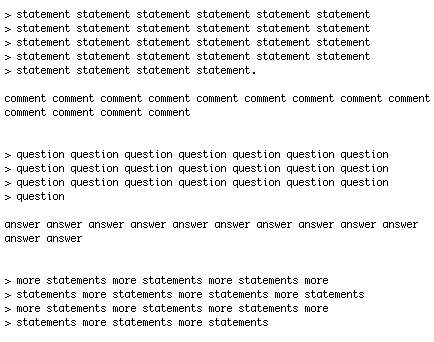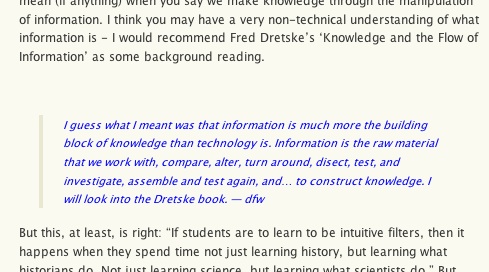When you reply to someone’s e-mail message, and you are answering a number of questions or commenting on a number of points in the e-mail,  it is considered a courtesy to include the original mail message, and to insert your answers or comments just beneath the questions and statements that they address. The text of the original e-mail is usually indented, with each line preceded with an angle bracket (>).
it is considered a courtesy to include the original mail message, and to insert your answers or comments just beneath the questions and statements that they address. The text of the original e-mail is usually indented, with each line preceded with an angle bracket (>).
Embedding your comments and answers into the original message turns it in to a conversation that can more easily be followed by your busy colleague.
E-mail is a private conversation, meant as an exchange of information. Carefully clipping, separating, and interrupting statements and questions with comments and answers serves to improve that conversation. Blogs are different, as Stephen Downes reminded me yesterday.
 Blogging is much more about publishing. Although there are certainly important elements of conversation wrapped around it, a weblog is usually intended for a broader audience, as are its comments. As such, blogging usually involves more thought and care in composing and formatting the text. A blog entry and its comments are more refined information products, and to insert a comment within someones posted blog or comment is an act of violating the integrity of their writing — and this is what I did yesterday morning to Stephen Downes comment on my blog (Is All Information Knowledge?).
Blogging is much more about publishing. Although there are certainly important elements of conversation wrapped around it, a weblog is usually intended for a broader audience, as are its comments. As such, blogging usually involves more thought and care in composing and formatting the text. A blog entry and its comments are more refined information products, and to insert a comment within someones posted blog or comment is an act of violating the integrity of their writing — and this is what I did yesterday morning to Stephen Downes comment on my blog (Is All Information Knowledge?).
It was certainly not my intent to violate his verbal space, only to expedite the conversation. But blogging being what it is — I did alter the integrity of his writing.
I apologize.
..and am thankful for the learning experience — though not an altogether pleasant one. I let Stephen Downes get under my skin, probably because I hadn’t had breakfast yet. Aside from our exchanges, it’s a pretty good conversation.
My point in talking about information is to suggest that we, as technology advocates, spend more time thinking about this new, vibrant, and dynamic information landscape, and less thinking about its technical conduit. I just think that asking teachers to integrate networked, digital, and dynamic information/conversation into their classrooms could be more productive than asking them to integrate technology.
technorati tags:warlick, technology, education, literacy, ethics, blogging, stephendownes
Blogged with Flock

David, yesterday’s post. Is All Inforamtion Knowledge?, is exemplary blogging on so many levels (defining literacy, the nature of blogging, ethics, learning through conversation, …). This post and that one, together, model a true gentleman’s approach to the blogosphere.
Don’t change anything about the way you keep changing. You’re setting an example for kids and adults alike.
Cheers,
Darren
David, I think what you did was just fine. Aren’t mashups and repurposing content some of the key principles / affordances of Web 2.0? I don’t think you “violated Stephen’s verbal space” by inserting your reply into it rather than putting it afterward. It’s your web site. You don’t even have to enable comments if you don’t want to. Yes, you want to respect the integrity of someone else’s comments. I think breaking it up slightly didn’t hurt his comment a bit.
Also, it’s arguable that he was ruder to you than vice versa (i.e., he said your discussion was odd, he said you weren’t as persistent as you could have been, his recommendation that you might do some background reading could be interpreted as paternalistic, etc.). I’m not saying he was rude, just that it could be construed that way.
Keep doing great work. Don’t sweat the small stuff. We have bigger fish to fry.
That’s cool, Dave. And this post is a classy response, which I note and appreciate.
I agree that it is more important for teachers to have dynamic conversations about the information and technology with students than it is for them to simply “integrate technology.” The conversations and interactions between teachers and students will cause a transformation in thinking in the teacher and in the students which is much more important than to simply use the technology. This transformation will lead to a better, more real world use of technology with students – something some teachers already do, but many more are still teaching in the same way they did 10 years ago – as the classic digital immigrants or analog adults. I also thank you and Stephen for clarifying blogging protocol. And I agree that it is useful when the blogger does post their name in the title of the blog. It is nice to have a real name associated with the words and thoughts being shared.